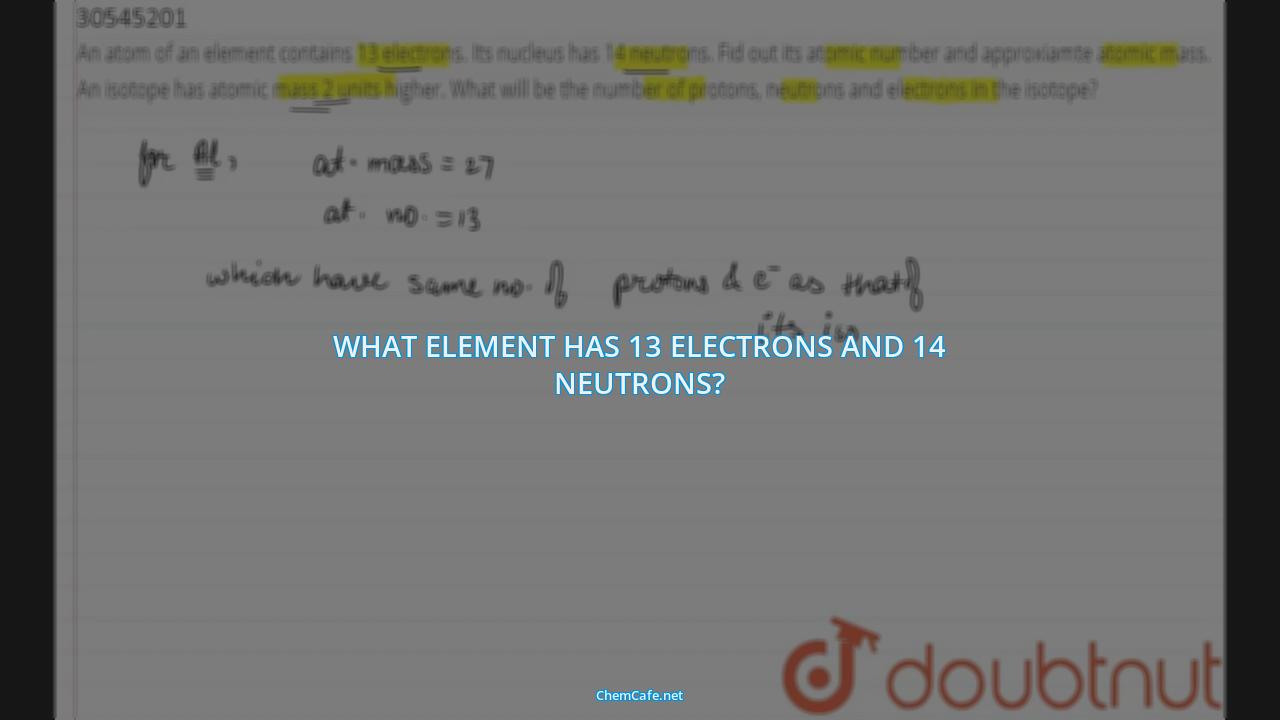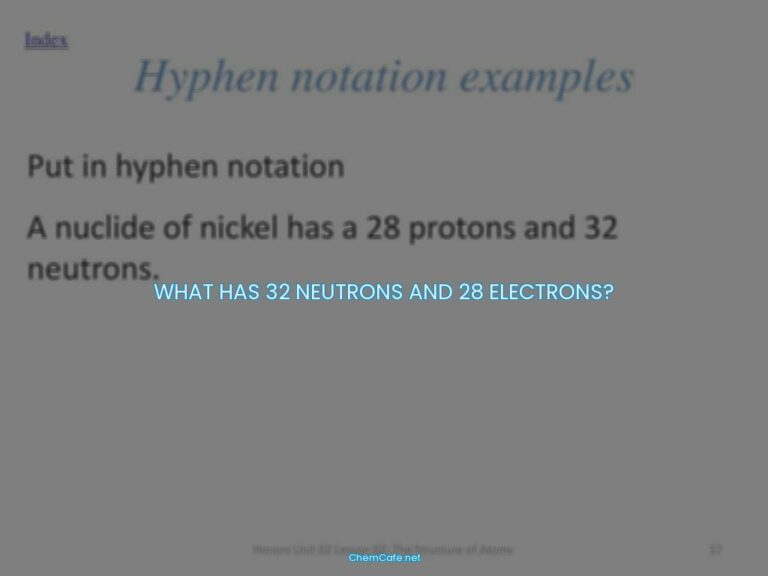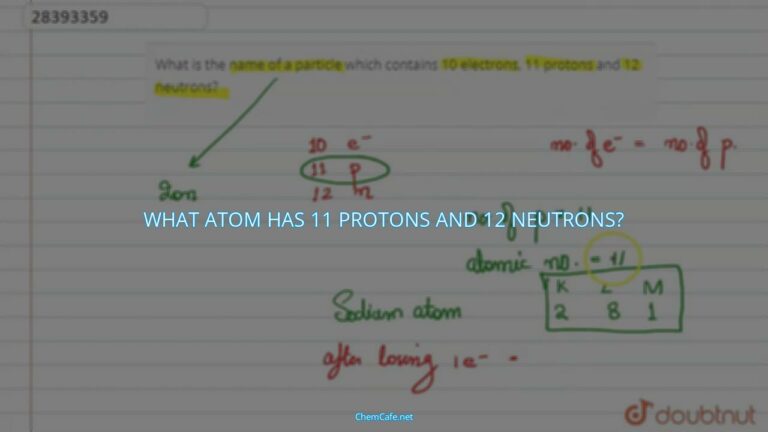Have you ever wondered what element has 13 electrons and 14 neutrons? Well, you’re in luck, because this blog post will answer that very question! Through a combination of jiggling about, calculation and a bit of knowledge about the atomic structure of atoms, we’ll be able to identify the element with 13 electrons and 14 neutrons.
Atoms are made up of protons, neutrons and electrons. Each atom has a unique combination of these three particles and can be identified by its atomic number, which is the number of protons, and its mass number, which is the sum of the protons and neutrons. By looking at an atom’s atomic number and its mass number, we can calculate the number of protons, electrons and neutrons it has.
Let’s take the example of aluminum. Aluminum has the atomic number of 13 and a mass number of 27. This means that the number of protons and neutrons in an atom of aluminum is 27. We can calculate the number of neutrons by taking the number of protons away from the number of protons and neutrons, which gives us 14 neutrons. Therefore, aluminum is the element that has 13 electrons and 14 neutrons.
This knowledge can be applied to any element. All you need to do is identify the atomic number and the mass number, and you will be able to calculate the number of protons, electrons and neutrons the element has. By doing this, you will be able to answer questions like “what element has 13 electrons and 14 neutrons?”
Atoms are the building blocks of our universe, and understanding their structure is the first step towards understanding the world around us. Knowing the number of protons, electrons and neutrons in an atom can help us to identify different elements and understand their properties. So, the next time you’re curious about the number of electrons and neutrons in an atom, you’ll know what to do!
What element has 13 electrons and 14 neutrons?
When it comes to understanding the components of atoms, it’s important to know how many electrons and neutrons each element has. The element with 13 electrons and 14 neutrons is aluminum. We can determine this by looking at the atomic number and mass number of aluminum.
Atomic Number and Mass Number of Aluminum
The atomic number of an atom is the number of protons in the nucleus of that atom. For this aluminum atom and indeed all aluminum atoms, the atomic number is equal to 13. Therefore, the number of protons in an atom of aluminum is 13.
The mass number, on the other hand, is equal to the number of protons and neutrons. For the aluminum atom which has the atomic number of 13 and has a mass number of 27, there are 27 protons and neutrons.
Calculating Electrons and Neutrons
Now that we know the number of protons and the number of protons and neutrons, we can calculate the number of electrons and neutrons.
We know that for a neutral particle, the number of protons is equal to the number of electrons. Therefore, for an atom of aluminum, there are 13 electrons inside it.
To calculate the number of neutrons, we can take the number of protons and neutrons away from the number of protons. In this case, the number of neutrons is equal to 27 protons and neutrons minus 13 protons, which we can simplify to 27 minus 13 which gives us 14 neutrons.
In conclusion, the element with 13 electrons and 14 neutrons is aluminum. We can determine this by looking at the atomic number and mass number of aluminum. The atomic number is equal to 13 and the mass number is equal to the number of protons and neutrons. By subtracting the number of protons from the number of protons and neutrons, we can calculate the number of neutrons, which is equal to 14.
What elements have 13 electrons 13 protons and 14 neutrons?
Atoms are the most basic building blocks of matter. They are made up of three main particles: protons, neutrons, and electrons. Each atom has a specific number of each particle, and the number of each particle determines the chemical properties of the atom. An atom with 13 protons, 13 electrons, and 14 neutrons is an atom of aluminum.
Atomic Number
The atomic number of an atom is the number of protons in the nucleus of that atom. For this aluminum atom and indeed all aluminum atoms, the atomic number is equal to 13. Therefore, the number of protons in an atom of aluminum is 13.
Number of Electrons
Atoms are electrically neutral, meaning they have the same number of electrons and protons. With a little bit of jiggling about, we can see that the number of protons is equal to the number of electrons from neutral particle. Therefore, for an atom of aluminum, there are 13 electrons inside it.
Mass Number
The mass number of an atom is the number of protons and neutrons in the nucleus. For this aluminum atom, the mass number is equal to 27. So we can calculate the number of neutrons by taking the number of protons away from the number of protons and neutrons. Therefore, the number of neutrons is equal to 27 protons and neutrons minus 13 protons, which we can simplify to 27 minus 13 which gives us 14 neutrons.
In conclusion, we can say that an atom of aluminum with the atomic number of 13 and has a mass number of 27, has 13 protons, 14 neutrons, and 13 electrons. This is important to remember when learning about the properties of different elements. Knowing the number of protons, electrons, and neutrons in an atom can give us insight into the chemical properties of that atom.
What element has 14 neutrons and 13 protons?
Atoms are composed of a cloud of electrons surrounding a dense nucleus that is 100,000 times smaller and comprised of protons and neutrons. The number of protons (i.e., atomic number, “Z”) determines the element; for example, a strontium nucleus always has 38 protons, and a rubidium nucleus always has 37. Neutrons, on the other hand, are not limited to a certain number for each element. This means that the same element can have different numbers of neutrons and still be the same element.
Isotopes are atoms of the same element that have different numbers of neutrons. The number of neutrons in an atom is referred to as its mass number, and this number varies from one isotope to another. For example, some strontium atoms have 50 neutrons, while others have anywhere from 44 to 52 neutrons. But they are still strontium because they all have 38 protons.
This means that the element with 14 neutrons and 13 protons is carbon. Carbon has 6 protons and 6 neutrons in its most common form, and this combination of protons and neutrons gives it a mass number of 12. However, when carbon has 14 neutrons and 13 protons, its mass number is 27, and it is referred to as a carbon-14 isotope.
Isotope Notation
Isotopes are notated in multiple ways. Most commonly, they are specified by the name or symbol of the particular element, immediately following by a hyphen and the mass number (e.g., carbon-14 or C-14). This notation can also be written using the atomic number and mass number (e.g., 6-14 or 6-14C).
What are Isotopes?
Isotopes are atoms of the same element that have different numbers of neutrons. This means that an atom of an element with a certain number of protons can have different numbers of neutrons and still be the same element. For example, carbon has 6 protons and 6 neutrons in its most common form, and this combination of protons and neutrons gives it a mass number of 12. However, when carbon has 14 neutrons and 13 protons, its mass number is 27, and it is referred to as a carbon-14 isotope.
Isotopes of an element can be identified by their mass, which is the total number of protons and neutrons. There are two ways that isotopes are generally written. They both use the mass of the atom where mass = (number of protons) + (number of neutrons). The first way is to write the element’s symbol and mass number (e.g., C-14 or 6-14). The second way is to write the element’s atomic number and mass number (e.g., 6-14 or 6-14C).
In conclusion, the element with 14 neutrons and 13 protons is carbon. Carbon-14 is one of the most abundant isotopes of carbon and is used in a variety of applications, such as radiocarbon dating. This isotope can be identified by its mass, which is 27 (14 neutrons + 13 protons). It can also be written in the form of its atomic number and mass number (6-14 or 6-14C).
What atom has 13 protons 14 neutrons and 13 electrons?
Atoms are made up of protons, neutrons, and electrons. The number of each of these particles that an atom has is what makes it unique and determines its properties. Some atoms have more protons than neutrons and vice versa, while some atoms have the same number of both. The atom that has 13 protons, 14 neutrons, and 13 electrons is aluminum.
Atomic Number and Mass Number
The atomic number of an atom is the number of protons in the nucleus of that atom. For aluminum, the atomic number is 13. This means that the number of protons in an atom of aluminum is 13. The mass number of an atom is the total number of protons and neutrons in the nucleus. For aluminum, the mass number is 27. Therefore, in this particular atom of aluminum, the number of protons and neutrons is 27. So we can calculate the number of neutrons by taking the number of protons away from the number of protons and neutrons. Therefore, the number of neutrons is equal to 27 protons and neutrons minus 13 protons, which we can simplify to 27 minus 13 which gives us 14 neutrons.
Number of Electrons
The number of electrons in an atom can be calculated by looking at the atomic number. Atoms are neutral particles, meaning that the number of protons is equal to the number of electrons. So for aluminum, the atomic number is 13, which means that there are 13 electrons in an atom of aluminum.
Conclusion
In conclusion, for an atom of aluminum, which has the atomic number of 13 and has a mass number of 27, there are 13 protons, 14 neutrons, and 13 electrons. As I’ve just said, those protons are to be found in the nucleus. With a little bit of jiggling about, we can see that the number of protons is equal to the number of electrons from neutral particle. Therefore, for an atom of aluminum, there are 13 electrons inside it. So we’ve demonstrated that for an aluminum atom which has the atomic number of 13 and has a mass number of 27, there are 13 protons, 14 neutrons, and 13 electrons.
How many protons neutrons and electrons does 27 13 Al have?
Atoms are made up of protons, neutrons and electrons. The number of protons, neutrons and electrons in an atom determine its chemical properties and is referred to as its atomic number. Aluminum is a chemical element with the symbol Al and atomic number 13. It has an atomic mass of 27 and is a member of the p-block elements. Therefore, 27 13 Al has thirteen protons, fourteen neutrons, and thirteen electrons.
What is Aluminum?
Aluminum is a silvery-white, soft, non-magnetic, ductile metal with a face-centered cubic crystal structure. It is the most abundant metal in the Earth’s crust, and the third most abundant element overall. Aluminum is highly reactive, so it is never found in its elemental form in nature. Instead, it is found in the form of compounds, such as aluminum oxide.
Number of Protons, Neutrons and Electrons in 27 13 Al
The number of protons in an atom of aluminum is equal to its atomic number, which is 13. Therefore, an atom of aluminum has thirteen protons. The number of neutrons and electrons in an atom of aluminum is determined by its atomic mass. The atomic mass of aluminum is 27. Therefore, in this particular atom of aluminum, the number of protons and neutrons is 27.
So we can calculate the number of neutrons by taking the number of protons away from the number of protons and neutrons. Therefore, the number of neutrons is equal to 27 protons and neutrons minus 13 protons, which we can simplify to 27 minus 13 which gives us 14 neutrons.
Aluminum also has thirteen electrons. Aluminum has a positive electric charge (+1e) and a rest mass equal to 1.67262 × 10−27 kg (938.272 MeV/c2)— marginally lighter than that of the neutron but nearly 1836 times greater than that of the electron. The proton has a mean square radius of about 0.87 × 10−15 m, or 0.87 fm, and it is a spin – ½ fermion.
Properties of a Aluminum Atom
The protons exist in the nuclei of typical atoms, along with their neutral counterparts, the neutrons. The difference between the mass number of the aluminum atom and the number of protons is fourteen. Therefore, an aluminum atom has fourteen neutrons. The number of neutrons depends on the isotope of the element. The aluminum atom has one stable isotope.
Element NameAluminumSymbolAlAtomic number13Atomic weight (average)26.982Protons13Neutrons14Electrons13Group13Period3Blockp-blockElectrons per shell2, 8, 3Electron configuration[Ne] 3s2 3p1Oxidation states+3
In conclusion, an aluminum atom has thirteen protons, fourteen neutrons, and thirteen electrons. This article discussed in detail how to easily find the number of neutrons, protons, and electrons in an aluminum atom. Knowing the number of protons, neutrons, and electrons in an atom can help us to understand the chemical properties of that atom and its behavior in different chemical reactions. It is important to remember that the number of protons, neutrons, and electrons can vary depending on the isotope of the element.
Does aluminum have 13 or 14 neutrons?
Aluminum is a post-transition metal element and its symbol is Al. It is the 13th element of the periodic table, so its atomic number is 13. This means an aluminum atom has thirteen protons and thirteen electrons. The number of neutrons in an atom can be determined by the difference between the atomic mass and the number of protons.
Atomic Properties of Aluminum
The aluminum atom has one stable isotope, and its properties are as follows:
- Element Name: Aluminum
- Symbol: Al
- Atomic number: 13
- Atomic weight (average): 26.982
- Protons: 13
- Neutrons: 14
- Electrons: 13
- Group: 13
- Period: 3
- Block: p-block
- Electrons per shell: 2, 8, 3
- Electron configuration: [Ne] 3s2 3p1
- Oxidation states: +3
Number of Neutrons in Aluminum
The number of neutrons in an aluminum atom can be determined by using the following formula: neutron number (n) = atomic mass number (A) – atomic number (Z).
Mass number (A): 26.982
Atomic number (Z): 13
Neutron number = A – Z: 26.982 – 13 = 14
Therefore, an aluminum atom has fourteen neutrons. This number of neutrons, along with the atomic number and mass number of the element, can tell us a lot about the element’s properties.
Isotopes of Aluminum
The aluminum atom can exist in different isotopic forms, which are called isotopes. An isotope is an atom of the same element that has a different number of neutrons, and thus a different atomic mass number.
Aluminum has one stable isotope, which is known as aluminum-27 (27Al). This isotope has 13 protons and 14 neutrons, giving it an atomic mass of 27. The other isotopes of aluminum are all unstable and have half-lives of less than a second.
In conclusion, an aluminum atom has thirteen protons and thirteen electrons, and fourteen neutrons. The number of neutrons in an atom can be determined by subtracting the atomic number from the atomic mass number, and the aluminum atom has one stable isotope.





Leave a Comment